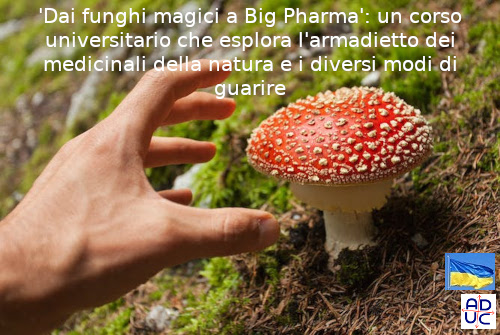Course title:
“From Magic Mushrooms to Big Pharma”
Where did the idea for the course come from?
I’m from the Appalachian foothills in southern Ohio, where my grandmother Mildred used to go into the woods, which she called her medicine cabinet, to find herbs to use as medicine. I grew up to be an anthropologist, interested in how people around the world heal themselves. In the 1990s, I did my thesis research in Ecuador and learned how the indigenous people of the Choco region used ayahuasca and other forest medicines to assist in mourning.
Con the legalization of cannabis in many states e the increase in research are how “non-traditional” drugs can help people with post-traumatic stress disorder, depression and addiction problems, it seemed like an opportune time to create this course. He is part of a new interdisciplinary minor at Western Illinois University called “Cannabis & Culture” which gives students a foundation for understanding the social and cultural context, history, and politics of the use of nature-based medicine in the United States and around the world.
What does the course explore?
The course examines how different peoples and cultures use nature-based medicines to heal themselves. First let’s establish that there are many ways to learn about the world around us, just as there are many ways to heal ourselves. Some of us rely on Western medicine, others pray, still others turn to indigenous or traditional healing methods that are rooted in nature.
Let’s talk about the ways Western medicine now seeks to validate substances that have been used for healing for centuries, such as research into how theor ginger and turmeric can relieve inflammationor the ways in which cannabis can reduce or even eliminate some epileptic seizures.
We also examine how the pharmaceutical industry exploited the knowledge e the ethnobotanical landscapes of indigenous peoples to get one financial gain.
Using the Amazonian giant leaf frog, or kambô (Phyllomedusa bicolor), as a case study, students learn that at least 15 indigenous groups have a long history of using frog secretion for its analgesic, antibiotic, and wound healing properties. Eleven patents related to P. bicolor have been granted, all in rich countries. The natives were not rewarded for their knowledge.
Why is this course relevant now?
The current generation of young people is open about mental health problems and many people are looking for new ways to deal with anxiety, grief, PTSD, and depression. My students can discuss their health concerns and learn about alternatives to what they may be used to.
In this politically and racially polarized time in the United States, the course also provides an opportunity to discuss about how racism, misogyny and discrimination against people of color have influenced scientific research.
What is a key lesson of the course?
Over the course of the semester, students begin to recognize that there is no right way to heal. More importantly, there is no right way to be human. I hope students leave seeing that everything is connected, integrally tied to humanity’s relationship with nature.
What materials does the course include?
– Scientific materials provided by Multidisciplinary Association for Psychedelic Studiesa non-profit organization that provides some of the only scientific research on psychedelics in the United States and promotes awareness of these drugs.
– “How to Change your Mind” (How to change your mind9, by Michael Pollan and the accompanying Netflix series
– Work by ethnobotanist Mark Plotkin, including his Ted Talk”What the people of the Amazon know that you don’t” (What the people of the Amazon know that you don’t know”
How will the course prepare students?
Studying how different cultures deal with problems that afflict all human beings, such as being sick and healing our ills, demonstrates to students that there are many ways around the world to solve problems. This course sees the different approaches not as a problem to overcome but as a resource that can lead to new ways of thinking and new opportunities, an undoubted advantage in the world of work. I hope students also learn to become advocates for their own health and well-being.
(Heather McIlvaine-Newsad – Professor of Anthropology, Western Illinois University -, su The Conversation del 09/06/2023)
the association does not receives and is against public funding (also 5 per thousand)
Its economic strength are inscriptions and contributions donated by those who deem it useful
DONATE NOW
